AWS Migration Services is a popular choice for companies that use digital transformation technology to change their business model. Those services offer tools and services designed to migrate workloads, data, and infrastructure to the cloud. We offer to consider our expert opinion on why we choose AWS migration services and how to migrate and modernize legacy infrastructure.
The global market for cloud computing is expected to reach a value of about $2,321.1 billion by 2032, growing at a compound annual growth rate (CAGR) of 16% between 2023 and 2032. The driving forces behind this tendency are:
- Artificial intelligence and machine learning technologies
- The rise of software as a service (SaaS) and remote work
- Data security
Source: Technopedia
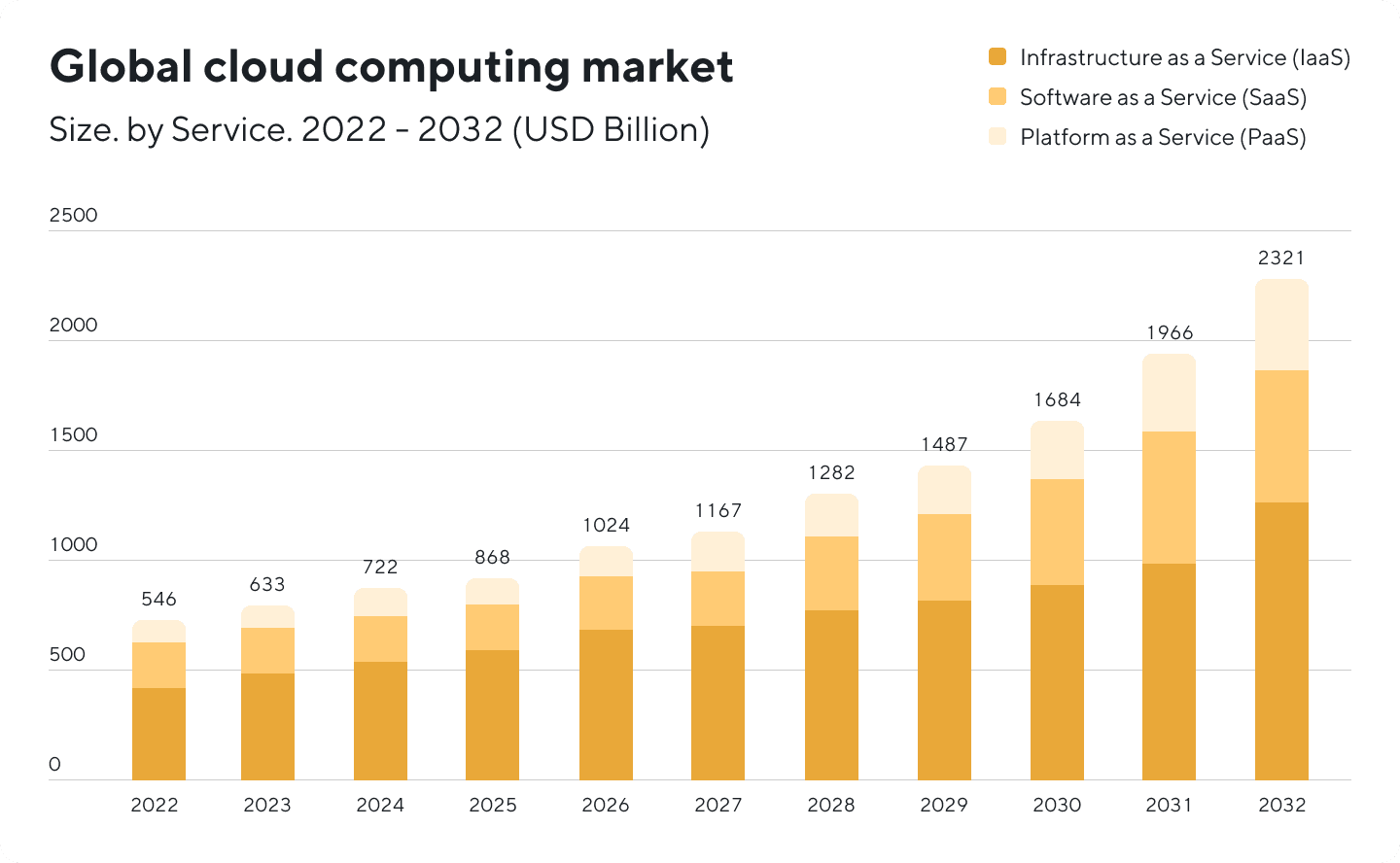
What Is Cloud Computing Services: SaaS, IaaS, and PaaS?
Cloud computing services offer solutions allowing businesses to access computing resources and software applications over the Internet. These services help reallocate resources from IT hardware, software, and labor costs to other business needs.
Software as a Service (SaaS)
Companies get SaaS applications via a web browser and no longer have to install, maintain or update the software on their own devices. Instead, the software is hosted on the provider’s servers and users usually pay for the service on a subscription basis. SaaS solutions are easy to access and use, reducing the need for internal IT management. They also allow users to collaborate in real time and access software updates automatically.
Examples of SaaS Applications:
Email and Communication: Gmail, Microsoft Outlook
Customer Relationship Management (CRM): Salesforce, HubSpot
Productivity: Google Workspace, Microsoft 365
Collaboration: Slack, Zoom
Project Management: Asana, Trello
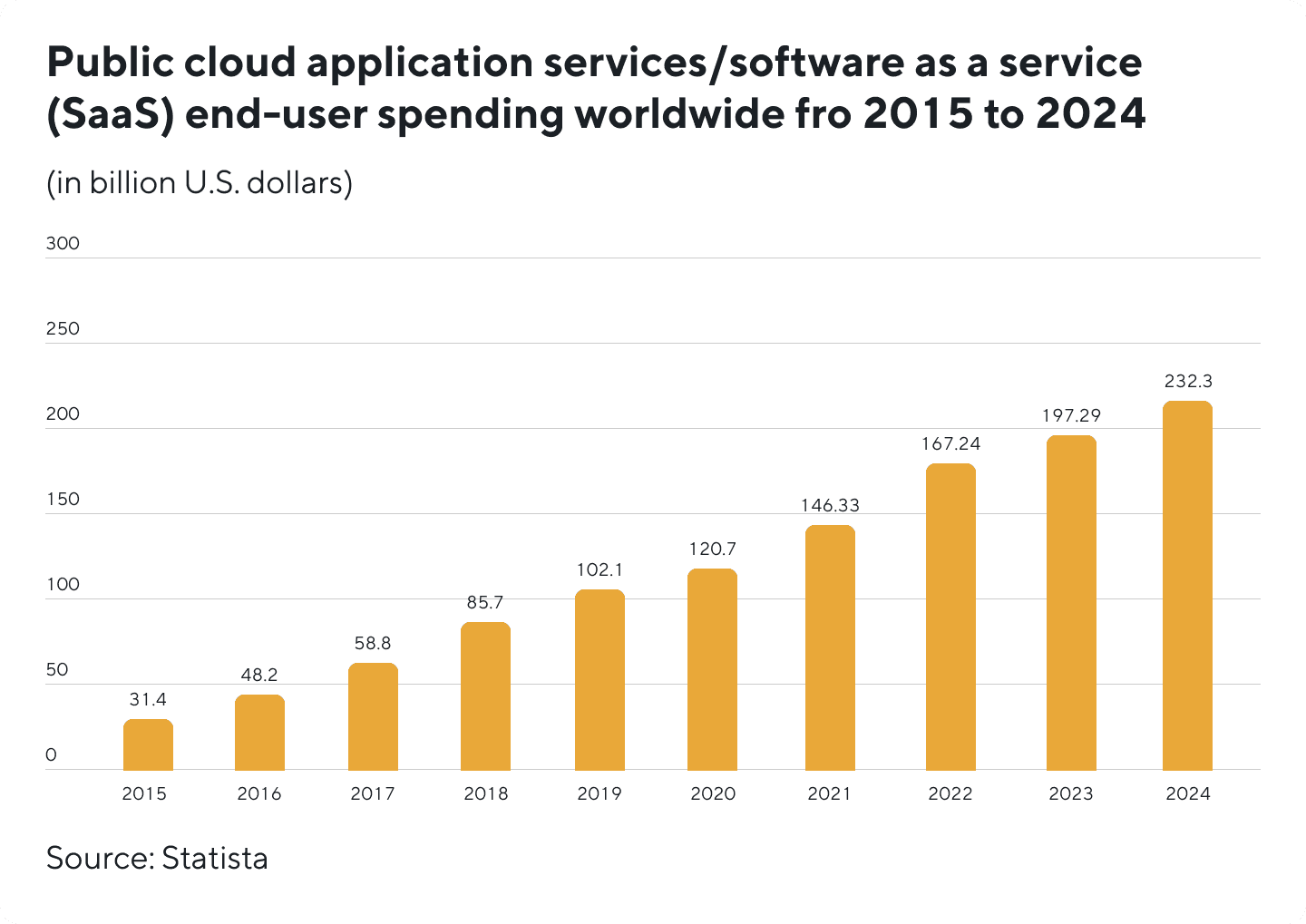
Infrastructure as a Service (IaaS)
IaaS provides virtualized computing resources over the Internet: servers, storage, and networking infrastructure that can be scaled up or down as needed. In other words, IaaS enables businesses to avoid the costs and complexities of purchasing and managing physical servers.
TOP – 4 Examples of IaaS Applications:
Amazon Web Services (AWS): AWS offers many infrastructure services, including computing power (EC2), storage (S3), and networking. It’s highly scalable, allowing businesses to grow their infrastructure as needed.
Use Cases: Hosting websites and applications, data storage and backups, big data analytics, disaster recovery.
Microsoft Azure: Azure provides various IaaS solutions, such as virtual machines, storage, and networking. It’s integrated with Microsoft products, making it a natural fit for businesses using Windows Server and other Microsoft technologies.
Use Cases: Application hosting, testing and development, data storage, machine learning.
Google Cloud Platform (GCP): GCP offers infrastructure services such as Compute Engine, Cloud Storage, and networking. It provides highly scalable and reliable infrastructure solutions.
Use Cases: Big data analytics, machine learning, application hosting, disaster recovery.
Alibaba Cloud: Alibaba Cloud is a leading cloud provider in Asia, offering IaaS services like ECS (Elastic Compute Service), storage, and networking.
Use Cases: E-commerce hosting, AI and machine learning, data storage and backup.
Infrastructure as a Service Revenue Worldwide Statista
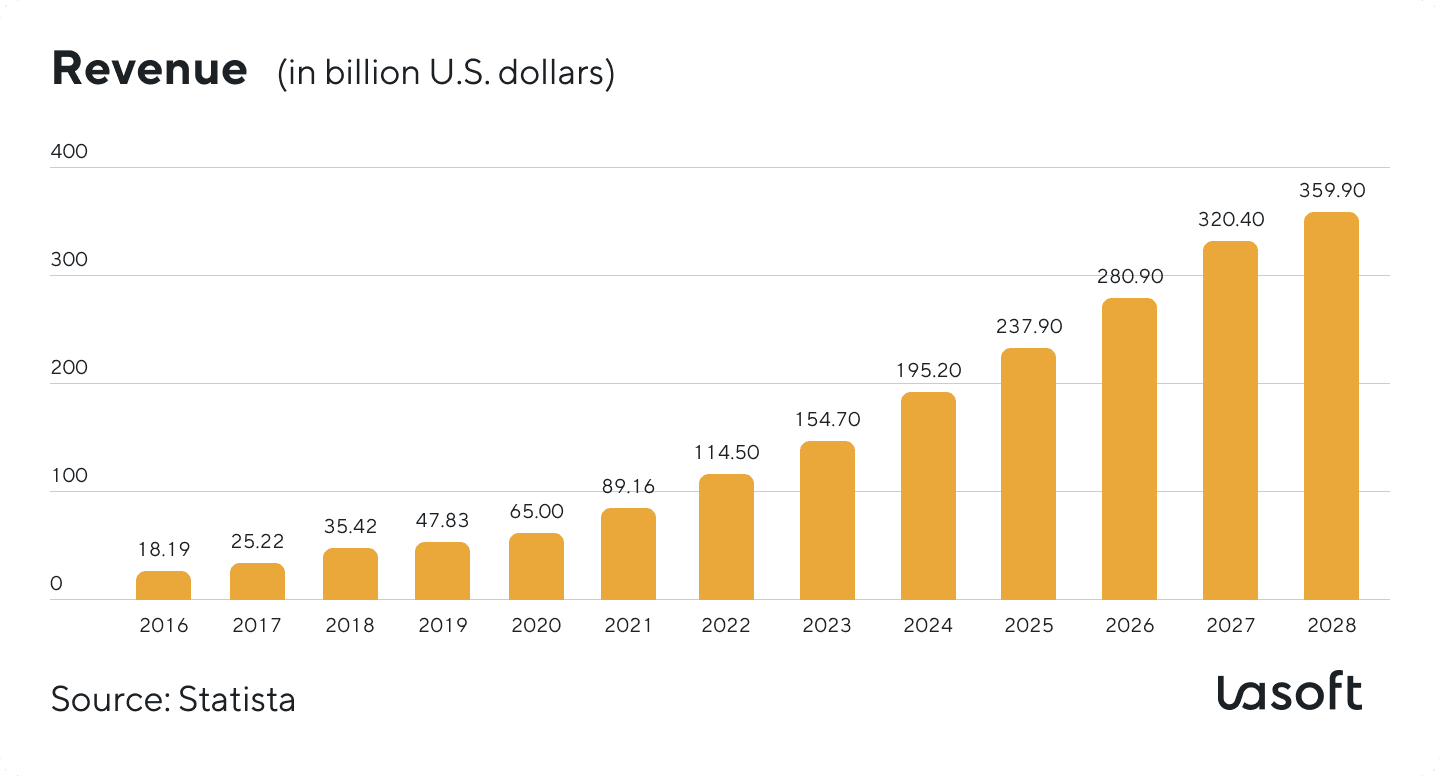
Platform as a Service (PaaS)
PaaS offers a platform that allows developers to build, test, and deploy applications without managing the underlying infrastructure. It typically includes development tools, database management systems, and middleware.
TOP-4 Examples of PaaS
Microsoft Azure App Service: A cloud platform that allows developers to build and host web apps, mobile back-ends, and RESTful APIs in any programming language without managing infrastructure.
Use Cases: Web and mobile app development, API development, serverless computing.
Google App Engine: A fully managed platform that automatically scales applications up and down based on traffic demands. It supports popular programming languages and provides built-in services like NoSQL databases.
Use Cases: Web applications, mobile back-ends, scalable APIs.
AWS Elastic Beanstalk: A PaaS solution from AWS that enables developers to deploy and manage applications without needing to handle the underlying infrastructure. It supports several programming languages and application frameworks.
Use Cases: Web applications, microservices, RESTful APIs.
Salesforce Platform: A platform designed to help businesses develop and deploy cloud-based applications with a focus on CRM integration. It offers various tools for building apps with minimal coding.
Use Cases: CRM applications, business processes automation, custom app development.
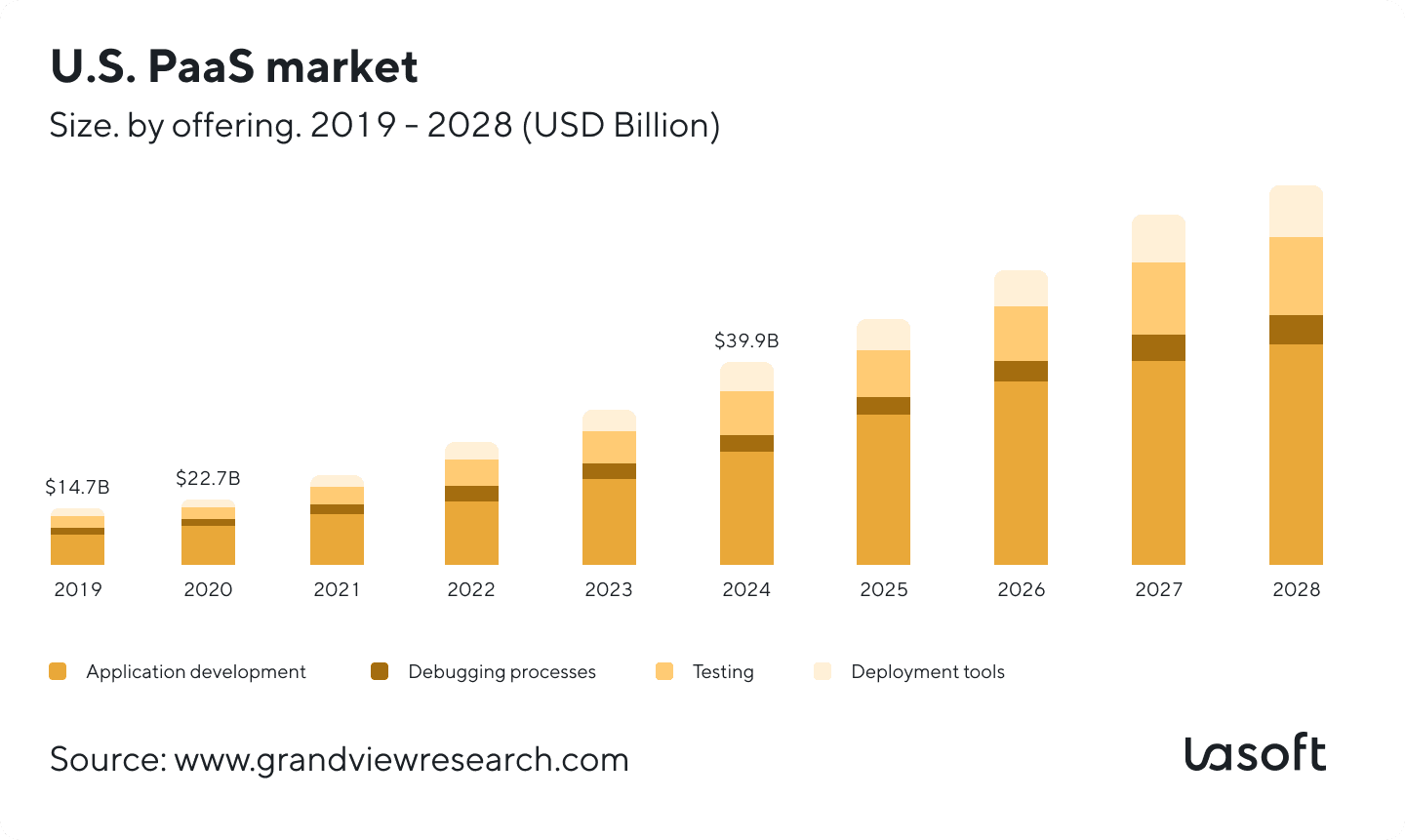
Source: Grandviewsearch
Models of Cloud Computing
It offers three models that cover businesses’ needs and requirements. Each cloud model provides unique capabilities and is suitable for different use cases.
Public Cloud Model
Third-party cloud service providers offer computing resources like servers, storage, and applications over the Internet. These resources are shared among multiple customers, but each user’s data remains private.
This model is considered a cost-effective solution due to its shared infrastructure, which is scalable and accessible from anywhere with an internet connection.
Examples: Amazon Web Services (AWS), Microsoft Azure, Google Cloud Platform.
Private Cloud Model
It’s a one-company solution that owns the cloud. It can be hosted on-premises or by a third-party provider and offers dedicated resources to ensure greater control over data and applications, security, and customized infrastructure according to specific needs.
Example: VMware vSphere, OpenStack, Microsoft Private Cloud.
Hybrid Cloud Benefits
This solution combines public and private cloud elements, allowing data and applications to be shared between them. The hybrid clouds provide businesses with flexibility by enabling them to use the appropriate cloud environment for each workload. It offers a balance between cost-effectiveness and control, with the ability to scale resources while maintaining compliance and security.
Example: Azure Stack, AWS Outposts, Google Anthos.
Each cloud model provides unique benefits and is suitable for different use cases.
Cloud Migration Market Analysis and Trends
The trend in the enterprise and SME markets shows an increasing move towards digital transformation technology and cloud-based services and solutions. Many companies consider the benefits of AWS application migration service globally. Below, you can examine Amazon Web Services’ revenue tendency to grow and generate almost $90.8 billion in 2023.
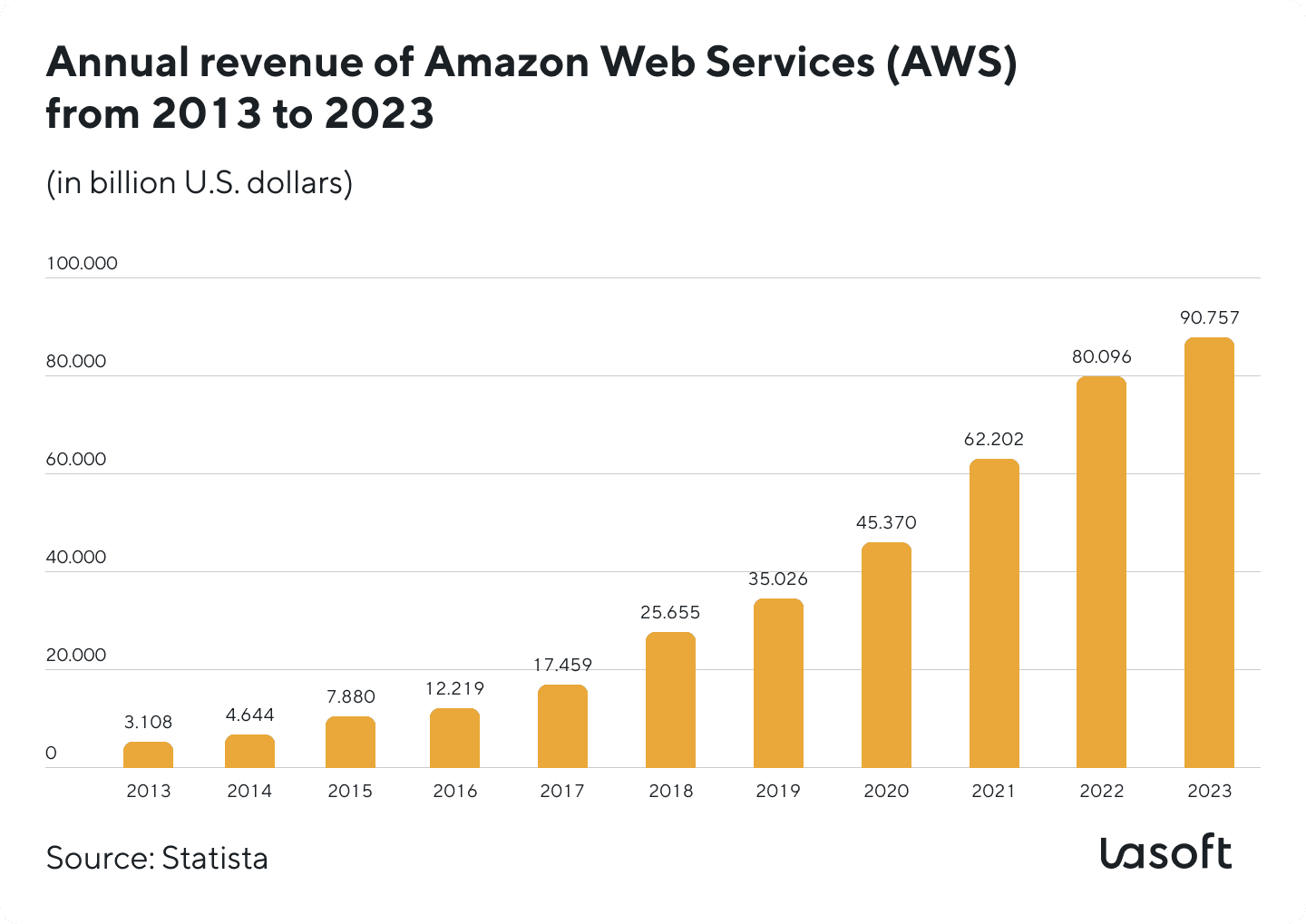
Thanks to the growing popularity of hybrid and multi-cloud solutions, businesses may now use cloud capabilities provided by numerous cloud providers and develop bespoke solutions for their infrastructure needs. New technologies revolutionizing the cloud and software development industry include edge computing, serverless architecture, and artificial intelligence integration.
- 94% of businesses make use of cloud services;
- 67% of enterprises host the cloud;
- 92% of enterprises implement a multi-cloud strategy;
- 48% of companies choose the cloud to store their most valuable data.
Source: Zappia
Amazon Web Services (AWS), the online retailer’s cloud platform, continues to lead the way in the cloud infrastructure business, having emerged as an early provider. Amazon’s market share in the global cloud infrastructure market dropped from 32% to 31% in the first quarter of 2024, according to estimates from Synergy Research Group. Microsoft, Amazon’s primary competitor, is gaining ground on Amazon and has increased the market share of its Azure platform to a record-breaking 25% in the first quarter of 2024. Source: Statista
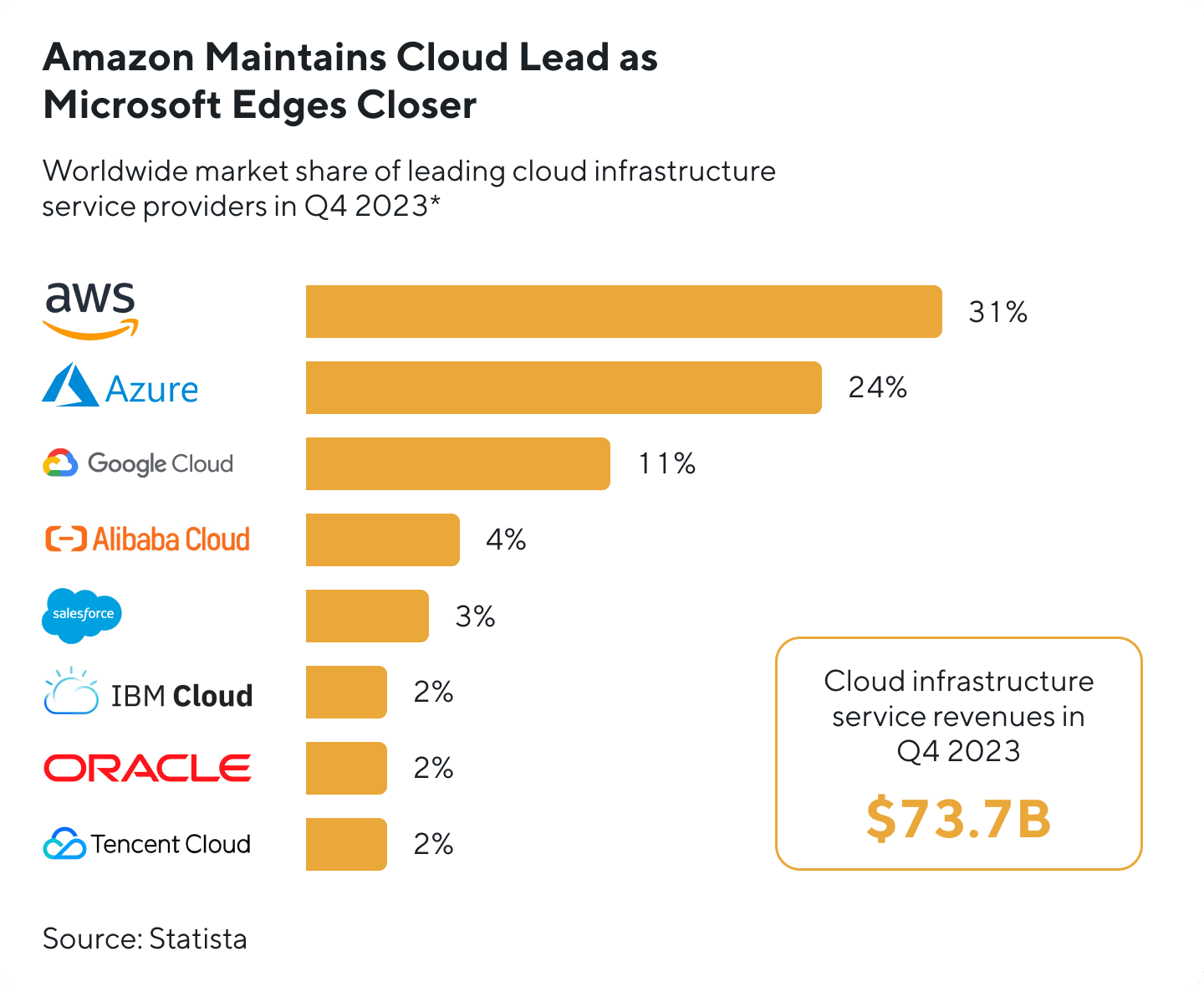
What is AWS Cloud Migration Services?
Amazon Web Services (AWS) is designed to assist companies in migrating their on-premises, cloud-based, or hybrid workloads to the AWS cloud. These services cover various migration needs, which include assessing a business’s current cloud environments and automating and managing the migration process.

Why Choose AWS Cloud Migrations?
Cloud computing has experienced impressive growth over the last ten years due to its numerous advantages. Cloud platforms became popular as companies realized the benefits of on-demand computing. Many companies opt for a reliable and expandable cloud computing platform. AWS services provide various options that effectively manage workloads, boost competitiveness, and increase business value.
With over one million users worldwide, AWS Cloud has gained the leading position among other cloud platforms. It enables migration strategies for databases, virtual servers, websites, and storage, and migrating applications to the cloud.
Your business will have the chance to perform steadily and grow in a safe and reliable AWS cloud infrastructure, which helps it adapt to the dynamic technological setting quickly. This makes many businesses move to the cloud ecosystem and enjoy its advantages.
Key benefits of migrating to AWS cloud solutions:
Simple to Use
AWS cloud platform allows vendors and application providers to securely and quickly host new or existing applications. The platform will simplify the process of using your resources and capabilities optimally.
High Flexibility
You can select the operating system (OS), database, web application platform and programming language to load the applications according to your requirements. In the virtual environment, you can design the elements that your application needs. This makes the migration process really easy and convenient.
Scalability
A key benefit of AWS migration is that you can use different elements to allow your application to scale according to changing demand. For example, you can use AWS tools, Elastic Load Balancing, and Auto Scaling to keep your application running optimally.
Security
Your data is safe when you migrate to the AWS cloud computing solution. AWS uses an end-to-end approach to ensure the cloud infrastructure has a world-class security framework. The approach taken by AWS aids in hardening the entire IT infrastructure, including operational physical and software measures. So, you can utilize AWS cloud migration techniques without having to worry about security concerns.
Cost-effectiveness
The idea is that migrating to the AWS cloud will not be costly for your business. In reality, your cost management will become much easier. You will only have to pay for storage space, computing power, and other resources that you need. You will not have to stick to long-term contracts or commitments. So one of the main benefits of AWS migration is that you will reduce costs for your infrastructure. You can focus on running your business efficiently and effectively.
Expert Tips: AWS Cloud Migration Strategy
AWS Cloud Migration services involve strategic steps to ensure a smooth transition from on-premises infrastructure to cloud-based services. Each phase is essential for a successful cloud migration, ensuring a structured, well-planned transition to AWS while minimizing risks and disruption.
Stage 1: Consider Cloud Migration as a Part of Digital Transformation Strategy
Assess your business ecosystem, the architecture of your current software products, and the changes you need to make to move from the plateau. Check your business goals and habitual workflow algorithm. Establish new goals to create a business case for your Amazon migration. What makes you include AWS migration in your digital transformation strategy? Are you transferring to increase reliability and scalability or save costs? Based on those objectives, determine which products and data you need to move to the cloud.
Stage 2: Planning and Research
After you’ve set your objectives, find the cross-functional team or dedicated partner portfolio and decide which migration techniques you can employ for each software product. Find out which of AWS’s migration-related solutions, like Server Migration Service (SMS), Database Migration Service (DMS), and Amazon DirectConnect, may apply to your case. Ensure stakeholders and managers support the migration process and understand this innovation, then proceed with a comprehensive migration strategy.
Stages 3 and 4: Design, AWS Migration, and Validation
When your dedicated team developed a thorough migration plan. You may start migration, checking how migration techniques and tools perform in your setting.
Design the architecture that will host your product in the AWS cloud. Experts will migrate data securely to AWS using encryption and other security measures to protect sensitive information, ensuring compatibility and minimal disruption to business operations.
Testing strategy, including unit testing, integration testing, and user acceptance testing (UAT), ensures the software meets specifications. QA team assesses the software’s performance under various loads to ensure it can handle expected usage scenarios. Verifying that the software adheres to relevant industry standards and regulations is essential to ensure legal and ethical compliance.
Stage 5: Operating within AWS
When your software product migrates to the cloud, its previous versions are turned off, and its operations are shifted to AWS (unless you choose a hybrid approach).

Summary
Many cloud providers are in the market, but Amazon Web Services are still the most popular among companies worldwide. AWS Migration Services are designed to help companies migrate to the AWS cloud as part of their digital transformation strategy and migration projects. This process involves several stages, including assessment of current infrastructure, planning and research, design and migration, and finally, operation in AWS. These stages and experts you hire aim to minimize risk and disruption while ensuring a smooth transition.
AWS is popular and acknowledged for its robust security measures, scalability, cost efficiency, and simplicity. It also allows for optimal resource utilization. These benefits make it a compelling # 1 choice for businesses looking to enhance their digital capabilities and adapt quickly to technological advancements.


